Memorable wins in Barcelona and Thessaloniki
Leinier Domínguez just turned 37 years old, so this is a suitable time to remember how he has become a household name among the chess elite. Born in Havana, he won the Cuban national championship five times, getting the title for the last time in 2016. In December 2018, Domínguez transferred federations and began to represent the United States.
Besides winning the Cuban national championship and the Capablanca Memorial (three times, in 2004, 2008 and 2009), Domínguez obtained a number of remarkable victories in tournaments abroad. 2008 was a big year for him, as he tied for first at the Biel Chess Festival with Evgeny Alekseev, finishing ahead of Magnus Carlsen, and won the World Blitz Championship played in Almaty, Kazakhstan, a tournament that included the likes of Vassily Ivanchuk, Peter Svidler and Alexander Grischuk.
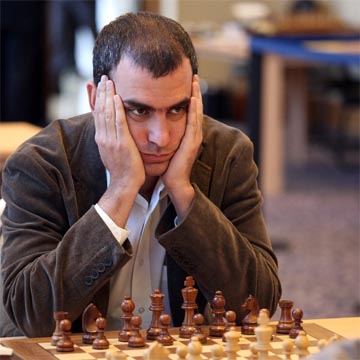 Nonetheless, we will focus on his astounding tournament victories in Barcelona 2006 and Thessaloniki 2013. In the former, he proved he had what is needed to break into the elite by scoring seven wins and two draws against a field that included international stars and strong representatives from Spain. In the latter, he defeated Veselin Topalov in the last round of a strongly contested event, in which he ended up leapfrogging Gata Kamsky in the standings table and getting a remarkable 2926 TPR (Tournament Performance Rating).
Nonetheless, we will focus on his astounding tournament victories in Barcelona 2006 and Thessaloniki 2013. In the former, he proved he had what is needed to break into the elite by scoring seven wins and two draws against a field that included international stars and strong representatives from Spain. In the latter, he defeated Veselin Topalov in the last round of a strongly contested event, in which he ended up leapfrogging Gata Kamsky in the standings table and getting a remarkable 2926 TPR (Tournament Performance Rating).
Both times, the Cuban-born grandmaster got tournament victory with wins in the very last rounds.
[Photo: Anastasiya Karlovich]
Ciutat de Barcelona 2006
Still rated 2655, a 23-year-old Domínguez arrived in Barcelona as the fourth seed of the event, with Vassily Ivanchuk, Viktor Bologan and Oleg Korneev ahead of him rating-wise. Peruvian star Julio Granda and Dutch legend Jan Timman were also in the mix.
Domínguez kicked off the event with a crucial win with black over Bologan. Out of a Najdorf Sicilian, the Cuban grandmaster expanded on both flanks of the board. Things got sharper when Bologan decided to open up the position on the kingside:
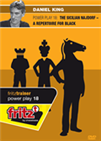 Learn the opening of the masters from one of the world's most popular master trainers! Daniel King shows you a rock-solid and powerful Najdorf repertoire.
Learn the opening of the masters from one of the world's most popular master trainers! Daniel King shows you a rock-solid and powerful Najdorf repertoire.
20.h4 turned out to be a bit hasty. The game continued 20...Nxh4 21.g3 Nxf3 22.Bxf3 Qxf3 23.Rxh6 Bg7 24.Qxg5 f6 25.Qh5:
Here Domínguez found the strongest continuation, 25...Ne5. Going for 25...Qxf2 must have been very tempting, and in fact White does not have a mating attack afterwards, but centralizing the knight was the way to go. The queens were swapped immediately afterwards and Black showed good technique to convert his positional advantage into a 49-move win.
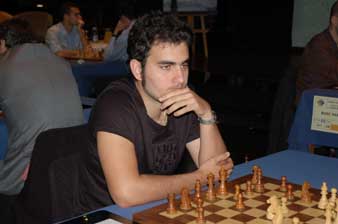
Leinier Domínguez at the Magistral Ciutat de Barcelona 2006
Two draws followed, against Timman and Korneev. And then came the streak of six wins that allowed him to win the event ahead of Ivanchuk.
Going into the last round he was a half point ahead of the Ukrainian genius in the standings table and had to play with the white pieces against him in a direct confrontation for the title. Ivanchuk played 1...g6, 2...d6 and 3...Bg7, showing his intentions to get a double-edged struggle. Domínguez responded in kind, giving up a pawn for activity on move 12:
 The Modern Pirc is actually a mixture of the Caro-Kann and the Pirc. In many lines Black combines the ideas of the classical Pirc in which the fianchettoed bishop is important with the Caro-Kann idea to fight for the center with c6-d5.
The Modern Pirc is actually a mixture of the Caro-Kann and the Pirc. In many lines Black combines the ideas of the classical Pirc in which the fianchettoed bishop is important with the Caro-Kann idea to fight for the center with c6-d5.
White has a space advantage and a chance to attack Black’s kingside, thus 12.g4 Nxg4 13.Ng5 Nxe3 14.Qxe3 e6 15.Qh3 h6:
White cannot back down now — 16.Nxf7 Qxf7 17.Rxg6 Qxf4+ 18.Kb1.
When the smoke cleared, Ivanchuk was a pawn up but also had a much weaker king and the queen’s opponent able to give perpetual check at any given moment. Domínguez knew that a draw would have been enough to secure tournament victory, but kept looking for tactical chances in the simplified position. His efforts were rewarded with a 69-move win over the strongest player in the field.
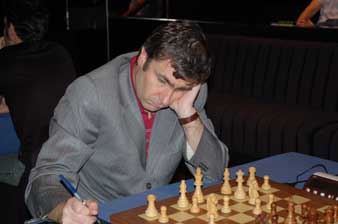
Unpredictable genius Vassily Ivanchuk in 2006
All Domínguez’s games from the tournament
Select an entry from the list to switch between games
Thessaloniki Grand Prix 2013
The fourth stage of the FIDE Grand Prix Series 2012-2013 was an incredibly hard-fought event, with Domínguez, Gata Kamsky and Fabiano Caruana the protagonists of a fierce struggle to get the title — in a field that also included top stars Alexander Grischuk, Hikaru Nakamura, Veselin Topalov, Alexander Morozevich and Vassily Ivanchuk.
Domínguez in fact kicked off the event with a loss, against Kamsky, who would end up sharing second place after reaching the last round in the lead. The Cuban’s luck turned around in round three, when Ivanchuk wasted a completely winning position playing white against him:
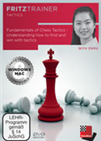 What’s the easiest way to win a chess game? We all know finding a good tactic in a game can let you win a point immediately. Therefore, Fundamentals of Tactics is an excellent choice for you if you wish to learn how to start finding tactics in your games!
What’s the easiest way to win a chess game? We all know finding a good tactic in a game can let you win a point immediately. Therefore, Fundamentals of Tactics is an excellent choice for you if you wish to learn how to start finding tactics in your games!
White has a clearly superior position, with the safer king and the more active pieces. Ivanchuk’s 32.Qxc8, however, gave Black some chances to look for counterplay (32.Bf4 or 32.Bg3 would have kept his large advantage). After 32...Qxe1+ 33.Kh2 Be5+ 34.Bxe5+ Qxe5+ g3 the engines still think White is better, but it is always difficult, psychologically, to go from clearly winning to slightly better. Domínguez had the momentum going for him and ended up outplaying Ivanchuk in the endgame.
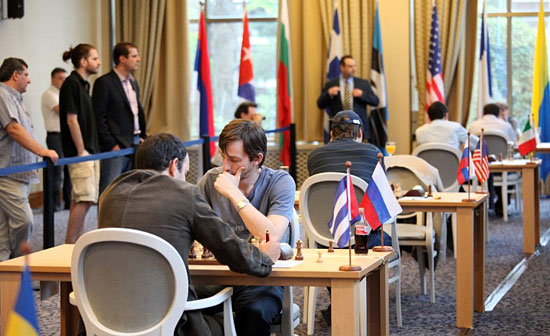
The playing hall in Thessaloniki | Photo: Anastasiya Karlovich
This was the first of a three-game winning streak, in which the Latin American defeated Peter Svidler and Rustam Kasimdzhanov in the next rounds. Two draws followed, and then two crucial consecutive wins, first against Morozevich and then against Caruana:
 The Ruy Lopez is one of the oldest openings which continues to enjoy high popularity from club level to the absolute world top. In this video series, American super GM Fabiano Caruana, talking to IM Oliver Reeh, presents a complete repertoire for White.
The Ruy Lopez is one of the oldest openings which continues to enjoy high popularity from club level to the absolute world top. In this video series, American super GM Fabiano Caruana, talking to IM Oliver Reeh, presents a complete repertoire for White.
As the official report mentioned, by playing 30...Rxb5, “Domínguez took the courageous decision to sacrifice an exchange, which crippled White’s pawns but more importantly gave the Cuban control of the only open file and of many key dark squares”.
Black ended up getting strong passed pawns in the centre, but White was still an exchange up. Caruana faltered on move 56:
56.Rd7+ was inaccurate (56.Rh2 would have left Black without a clear path to make progress), as it gave Domínguez the chance to hide his king on b3 and advance his d-pawn — 56...Kc4 57.Rc7+ Kb3 58.Rh2 Rg3 59.Rd7 d3+ and Black went on to score the full point six moves later.
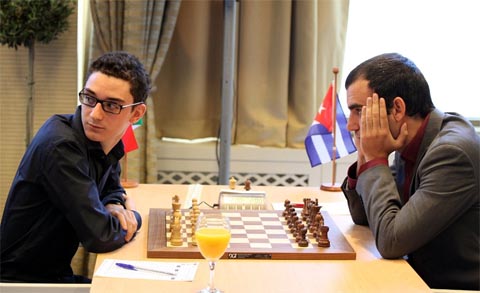
Fabiano Caruana v Leinier Domínguez | Photo: Anastasiya Karlovich
With two rounds to go, Domínguez was sharing the lead with Kamsky. In round 10, however, Kamsky beat Morozevich and Domínguez only drew with Grischuk. In the last round, Kamsky had black against Caruana, while the Cuban had white against Topalov. Caruana and Domínguez won, giving the latter tournament victory and a remarkable 2962 TPR.
GM Cristian Chirila analyzed both key last-round encounters:
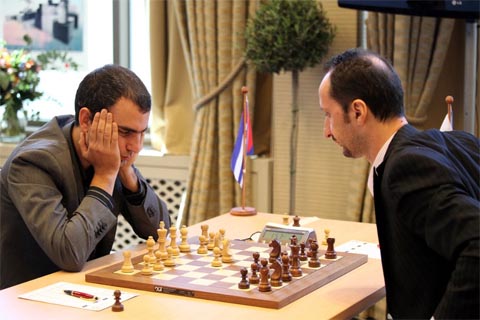
Leinier Domínguez v Veselin Topalov | Photo: Anastasiya Karlovich
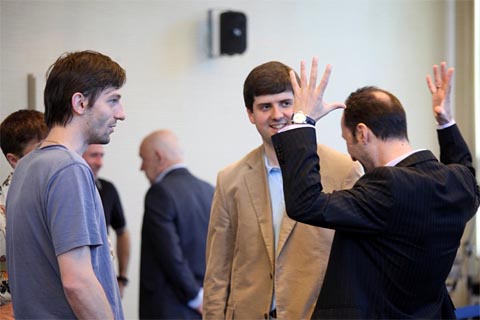
“And then the b-pawn advanced and advanced and advanced!” Grischuk, Svidler and Topalov | Photo: Anastasiya Karlovich
All Domínguez’s games from the tournament
Links
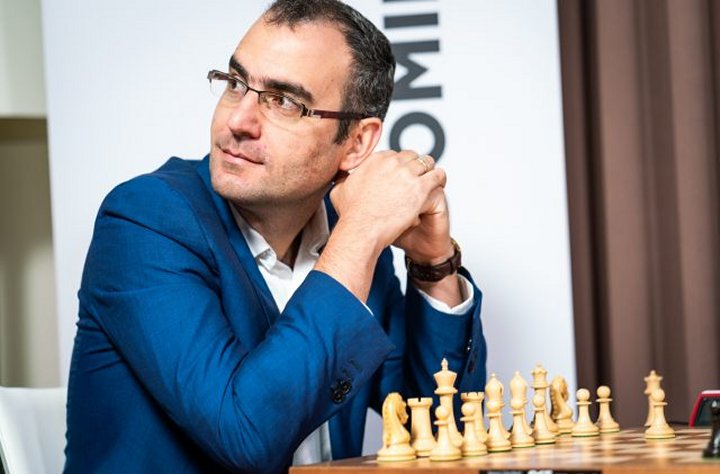

















 Nonetheless, we will focus on his astounding tournament victories in Barcelona 2006 and Thessaloniki 2013. In the former, he proved he had what is needed to break into the elite by scoring seven wins and two draws against a field that included international stars and strong representatives from Spain. In the latter, he defeated Veselin Topalov in the last round of a strongly contested event, in which he ended up leapfrogging Gata Kamsky in the standings table and getting a remarkable 2926 TPR (Tournament Performance Rating).
Nonetheless, we will focus on his astounding tournament victories in Barcelona 2006 and Thessaloniki 2013. In the former, he proved he had what is needed to break into the elite by scoring seven wins and two draws against a field that included international stars and strong representatives from Spain. In the latter, he defeated Veselin Topalov in the last round of a strongly contested event, in which he ended up leapfrogging Gata Kamsky in the standings table and getting a remarkable 2926 TPR (Tournament Performance Rating).










